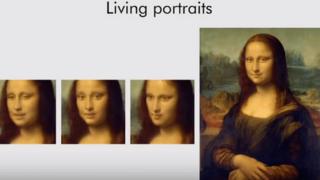Mona Lisa 'brought To Life' With Deepfake AI
 Image copyright
Samsung
Image copyright
Samsung
The subject of Leonardo da Vinci's famous Mona Lisa painting has been brought to life by AI researchers.
The video, achieved from a single photo, shows the model in the portrait moving her head, eyes and mouth.
The latest iteration of so-called deepfake technology came out of Samsung's AI research laboratory in Moscow.
Some are concerned that the rise of convincing deepfake technology has huge potential for misuse.
Samsung's algorithms were trained on a public database of 7,000 images of celebrities gathered from YouTube.
The AI system mapped facial features and movements on to a photo to bring it to life.
It also made videos of Salvador Dali, Albert Einstein, Fyodor Dostoyevsky and Marilyn Monroe.
In a paper outlining its work, the Samsung team called its creations "realistic neural talking heads".
There was a mixed reaction to the video demonstrating how the system worked with one describing it as like "watching the future of SkyNet unfold".
Researchers at Tel Aviv University showed off a similar system in 2017.
A fake video of President Barack Obama was created by Dr Supasorn Suwajanakorn in 2017.
Talking to the BBC, the researcher acknowledged that the technology could be misused but he added it could also be used as a force for good, such as allowing grieving relatives to create avatars of family members after they die.
Experts have previously said that fake videos of politicians could fool entire populations and the issues do not stop at political manipulation.
Deepfake technology has also been used to manipulate photos of celebrities to create pornography.
Dave Coplin, chief executive of AI consultancy The Envisioners, said: "The rise of convincing deepfakes is something that could be really problematic unless we have this conversation. Members of the public need to know how easy it is to create convincing fake videos."
From Chip War To Cloud War: The Next Frontier In Global Tech Competition
The global chip war, characterized by intense competition among nations and corporations for supremacy in semiconductor ... Read more
The High Stakes Of Tech Regulation: Security Risks And Market Dynamics
The influence of tech giants in the global economy continues to grow, raising crucial questions about how to balance sec... Read more
The Tyranny Of Instagram Interiors: Why It's Time To Break Free From Algorithm-Driven Aesthetics
Instagram has become a dominant force in shaping interior design trends, offering a seemingly endless stream of inspirat... Read more
The Data Crunch In AI: Strategies For Sustainability
Exploring solutions to the imminent exhaustion of internet data for AI training.As the artificial intelligence (AI) indu... Read more
Google Abandons Four-Year Effort To Remove Cookies From Chrome Browser
After four years of dedicated effort, Google has decided to abandon its plan to remove third-party cookies from its Chro... Read more
LinkedIn Embraces AI And Gamification To Drive User Engagement And Revenue
In an effort to tackle slowing revenue growth and enhance user engagement, LinkedIn is turning to artificial intelligenc... Read more

